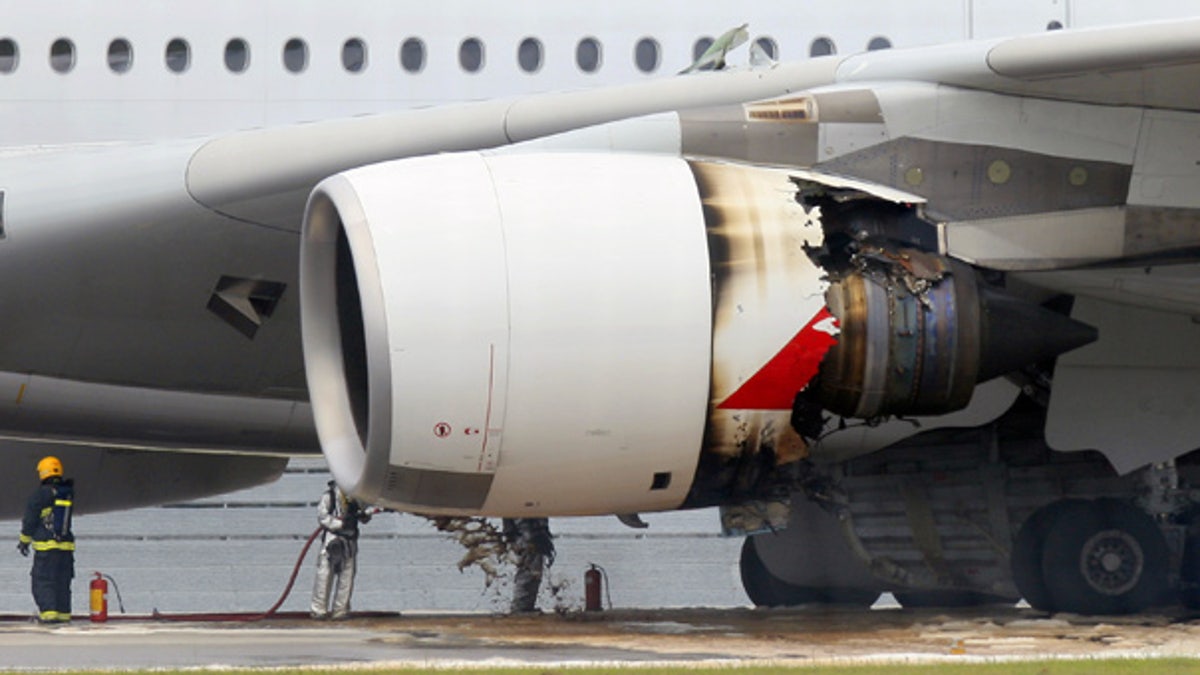
Nov. 4: A Qantus A380 jumbo jet made an emergency landing in Singapore after suffering engine failure in mid-air. (AP)
SYDNEY, Australia -- Qantas said faulty engine design or material failure were the most likely causes of an engine blowout on one of its Airbus A380 superjumbos, and confirmed Friday that pieces from the engine had pierced the plane's wing.
Qantas CEO Alan Joyce said it was too early to say exactly what caused one of the plane's four Rolls-Royce engines to fail shortly after takeoff from Singapore on Thursday and that a thorough investigation was under way. But he said maintenance -- for which the airline has responsibility -- did not appear to be a significant factor.
"This is an engine issue, and the engines have been maintained by Rolls-Royce since they were installed on the aircraft," Joyce told a news conference in Sydney. "We believe this is probably most likely a material failure or some type of design issue. We don't believe this is related to maintenance in any way."
The A380 suffered an engine blowout about four minutes after taking off from Singapore, shooting flames and shedding metal over an Indonesian island. It landed safely in Singapore after dumping its fuel.
It was the most serious midair incident involving the double-decker A380, the world's largest passenger jet, since it debuted in October 2007 with a Singapore Airlines flight to Sydney -- the same route the Qantas plane was flying when its engine failed.
The plane's manufacturer, Airbus, said Friday it has asked all airlines operating A380s with Rolls-Royce engines to inspect them to ensure safety.
Airbus has delivered a total of 37 A380s so far. Thirteen are in service with Emirates, 11 with Singapore Airlines, six with Qantas, four with Air France and three with Lufthansa.
Qantas' fleet of A380s remained grounded Friday. Singapore Airlines, which also grounded its A380s after the Qantas incident, said it has resumed flights after completing precautionary checks.
Lufthansa said it was still conducting inspections but expected to be able to fly an A380 from Frankfurt to Tokyo as scheduled Friday. On Thursday, it held back an A380 for checks and instead flew an A340-600 on a flight from Frankfurt to Johannesburg, airline spokesmen said.
Emirates airlines said all of its A380s are flying as scheduled, noting its planes aren't powered by Rolls-Royce engines.
Joyce said Qantas would complete its checks within 24 to 48 hours, and if no problems are found the planes would resume flying.
He confirmed that the engine failure caused damage to the plane's wing.
"Parts of the engine did go into the wing of the aircraft ... that was part of what made this a significant engine failure," he said.
The engine closest to the fuselage on the left wing had visible burn marks and was missing a plate section painted with the red kangaroo logo of the airline. The upper part of the left wing had raised and torn metal.
Ian Sangston, general manager of air safety investigation at the Australian Transport Safety Bureau, said the faulty engine was being removed for inspection and the rest of the plane was being examined, too. The flight data and cockpit voice recorders had been recovered and brought to Australia, where their contents would be analyzed.
Key clues to what happened, and why, would likely come from the debris that was scattered across Batam island in Indonesia when the blowout occurred. No one was injured by the falling material, which included more than 100 pieces, some as large as doors.
"We've got to gather those items from Batam, which will probably prove very interesting to our technical people as in they will show fracture surfaces and so on," Sangston told a news conference in Canberra, the Australian capital.
He said there was no suggestion maintenance workers may have been responsible for the engine blowout, but cautioned that the investigation was in its very early stages.
Sangston said it was the first such incident involving the combination of an A380 and the type of engine, a Trent 900.
The agency will issue a preliminary report by Dec. 3, though the full investigation could take one year, Sangston said.
The stricken A380 was carrying 440 passengers and 26 crew. Qantas had earlier said the plane was carrying 433 passengers but corrected the number on Friday without an explanation.
The passengers were flown to Australia on other flights Friday.




















